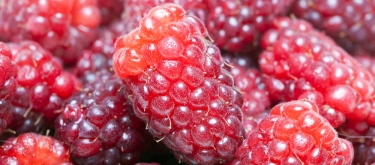Category: Fruits and Berries
Loganberry: Taste, Uses, and Benefits
Loganberry (Rubus × loganobaccus) is a unique hybrid berry resulting from the natural cross-pollination of blackberry (Rubus fruticosus) and raspberry (Rubus idaeus). Known for its rich, tangy flavor and deep reddish-purple color, loganberry is prized for its complex taste and versatility in culinary applications. Though less common than its parent fruits, loganberry holds a special place in the hearts of berry enthusiasts and chefs.
What does Loganberry taste like?
Primary Flavor Characteristics
Loganberry combines the best qualities of blackberry and raspberry. Its flavor is tangy and slightly tart, with a subtle sweetness that becomes more pronounced as the berry ripens. It has a deeper and more robust taste than raspberry but is milder than blackberry, making it a perfect balance of both.
Aromatic and Taste Nuances
Loganberry’s aroma is fruity and slightly floral, reminiscent of its parent fruits but with a unique depth. The taste is juicy and complex, offering an earthy undertone that complements its sweet and tart profile.
Scientific Description of Taste and Aroma
- Aroma: Fruity, with light floral and earthy notes.
- Taste: Tangy and tart, with balanced sweetness and a mild earthy depth.
- Texture: Juicy, with tiny seeds that add a slight crunch.

In-Depth Flavor Analysis of Loganberry
Underlying Flavor Notes:
- Tanginess: A sharp, refreshing tartness dominates the flavor.
- Sweetness: Subtle but present, especially in fully ripened berries.
- Earthy Undertones: Adds depth and richness to the flavor profile.
- Juiciness: Amplifies the overall flavor, making it refreshing and satisfying.
Impact of Preparation on Flavor:
- Raw: Offers its most balanced sweet-tart flavor, perfect for snacking or garnishing.
- Cooked: Heat enhances the sweetness, creating a jammy richness ideal for desserts.
- Frozen: Retains much of its tangy flavor, making it suitable for smoothies and sauces.
Culinary Uses of Loganberry
Loganberry’s versatility makes it a standout ingredient in both sweet and savory recipes. Its tangy flavor pairs well with a variety of ingredients.
Primary Uses:
- Desserts: Used in pies, tarts, cobblers, and sorbets.
- Jams and Preserves: High pectin content makes it ideal for creating jams and jellies.
- Beverages: Infused into teas, juices, and cocktails for a fruity twist.
- Sauces: Reduced into a glaze or sauce for meats like pork or duck.
- Breakfast: Perfect as a topping for pancakes, waffles, and yogurt.
Ideal Pairings:
- Sweet: Pairs well with chocolate, vanilla, and honey.
- Savory: Complements goat cheese, aged cheddar, and balsamic vinegar.
- Fruits: Blends harmoniously with strawberries, blueberries, and peaches.
- Herbs: Mint and basil enhance its fruity notes.
Health Benefits of Loganberry
Loganberry is rich in essential nutrients and antioxidants, making it a healthy addition to any diet.
Key Nutrients and Benefits:
- Vitamin C: Boosts immunity and promotes healthy skin.
- Fiber: Aids digestion and helps regulate blood sugar.
- Antioxidants: Anthocyanins and polyphenols reduce inflammation and oxidative stress.
- Low-Calorie Snack: A guilt-free option with only about 50 calories per 100 grams.
- Manganese: Supports bone health and energy production.
Potential Precautions:
- Seeds: The small seeds may be bothersome for sensitive stomachs.
- Allergies: Rare but possible, especially for those allergic to similar berries.

Tips for Choosing and Storing Loganberry
How to Choose Quality Loganberry:
- Color: Look for vibrant, deep reddish-purple berries without discoloration.
- Firmness: Ripe berries should feel firm yet tender to the touch.
- Aroma: A fresh, fruity smell indicates ripeness.
Storage Recommendations:
- Refrigeration: Store in a breathable container in the fridge for up to 3 days.
- Freezing: Freeze individually on a tray before transferring to an airtight bag for long-term storage.
- Preservation: Turn into jams or syrups to extend shelf life while preserving flavor.
Fun Facts About Loganberry
- Accidental Discovery: Loganberry was accidentally created in California in the late 19th century by Judge James Harvey Logan.
- Unique Hybrid: Combines the best traits of blackberry and raspberry in flavor and texture.
- Global Appeal: Popular in regions like New Zealand, the United States, and the UK.
- Niche Cultivation: Despite its delicious taste, it remains less commonly grown than its parent fruits.
Resources
Books and Publications for Further Reading:
- "The Berry Grower: Inspiring Passionate Farmers" by Blake Cothron
– Offers insights into cultivating and using hybrid berries like loganberry. - "On Food and Cooking: The Science and Lore of the Kitchen" by Harold McGee
– Discusses the chemistry and culinary potential of berries, including hybrids. - "The Fruit Gardener's Bible" by Lewis Hill and Leonard Perry
– Provides practical advice on growing and harvesting loganberries and other fruits. - "The Curious Gardener's Almanac" by Niall Edworthy
– Features fascinating facts and tips about cultivating unique fruits like loganberry.